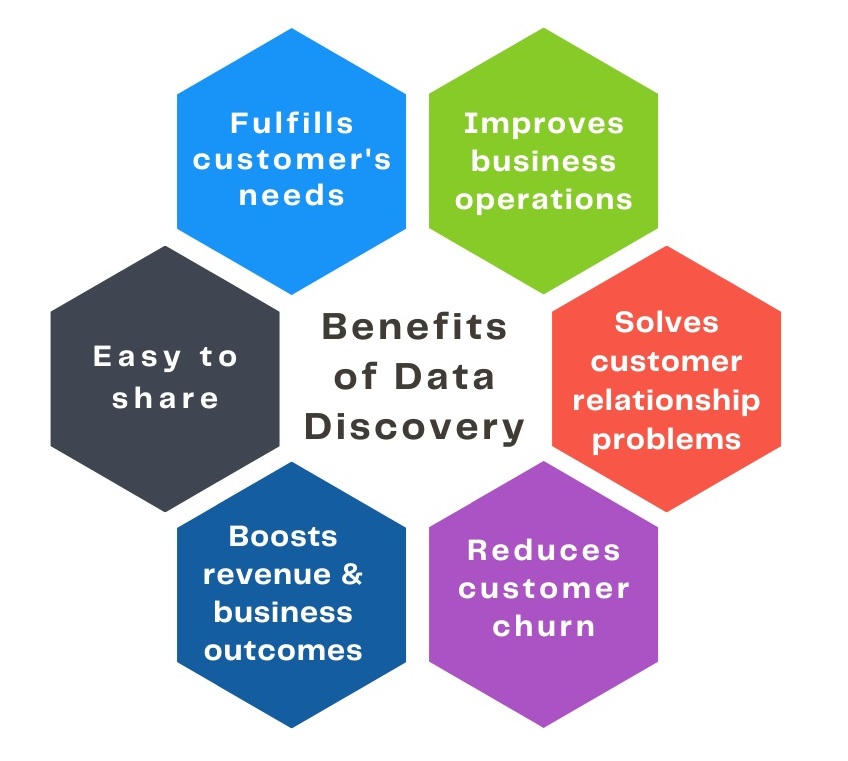Why Does Data Discovery Matter To Enterprise
In today’s day and age, data is continually being generated and analyzed. Most businesses need to access information that is clean, which means it is as error-free as possible, and structured, in order to make strategic decisions. This is known as data discovery and is part of the data intelligence process.
Table Of Contents
One of the keys is that it must be transparent and searchable. This allows for various levels of discovery and puts all of the information in one place for easy searching.
What Is Data Discovery?
In data discovery, various sources of data are collected and evaluated for the purpose of finding patterns in the data. Organizations can use it to better understand their data through a progression of steps. Following this, data has to be cleaned, which is called data wrangling. By fusing different sources of data for analysis, data discovery can aid the process of business decisions. This obviously means the data you collect is useless till you find a way to extract meaning from it. In the process of data discovery, multiple data sources are connected, data is cleansed and prepared, data is shared across the organization, and analysis is performed.
Actionable insights are the primary benefit of data discovery. These insights help businesses see opportunities before their competition. Visual data discovery can enhance this value, allowing workers to get answers faster.
Why Is Data Discovery Creating Such A Buzz?
A popular question that enterprises are asking these days is, “What is the importance of data discovery?”
In order to discover any trends or patterns in your data, you need to know what that information is. Also, data needs to be cleaned and prepared before analysis. Data cleansing or data wrangling makes the data easier to understand. More specifically, you want to “clean” data that is in a format that is easy to parse through.
Eventually, analyzing data in this entire process of looking at data and trying to find trends and patterns helps a business arrive at conclusions. There’s always the chance that you get confused between data discovery and data mining. Very quickly, data discovery is one part of data mining. So data mining, also sometimes referred to as knowledge discovery in data, is a process of using advanced mathematical methods on large data sets that have a known structure.
Data mining is a subset of data analysis, and its goal is to uncover trends and patterns in the data that can be used to predict future outcomes. Because data discovery is a process of looking at data and making inferences to understand it better, organizations can use this to make better decisions about their business. Looking at a mass of data and not being able to find the information you are looking for is like looking for a needle in a haystack: it takes more time and can be frustrating, but it still helps to know where you are looking.
On the other hand, the goal of data discovery is to uncover relevant data insights, to communicate these insights in a democratic way to even non-technical users, and to ultimately improve business processes. Using visual data discovery tools and business intelligence tools, users can extract data from various sources and consolidate it into a single location, enabling them to understand their data in a holistic manner.
What Are The Benefits Of Data Discovery?
Data Discovery Tools For The Modern Age
Data discovery tools are becoming more complex with the amount of data being generated. As organizations struggle to find information, they are turning to data discovery tools to help them find the data that is relevant to their job.
The modern era is all about data: the amount of data being generated is more than any organization can analyze. As organizations turn to data discovery tools, they are using them to help them find the data that is relevant to their job. According to one estimate, there are about 100 exabytes of data created every year. Of that amount, about 40 percent is digital data, which means that about 70 exabytes are hard copy data, which is not suitable for retrieval.
How Does Data Discovery Help The Enterprise?
Prior to advanced machine learning techniques, data specialists mapped their data using only their brains. The company critically examined its data, where it was stored, and what it should provide to its end users.
Nowadays, technological advances make it possible to present data in an automated manner. Data technologies such as augmented analytics, machine learning, and artificial intelligence are used in “smart” data discovery.
The system prepares, conceptualizes, and integrates data while revealing hidden patterns and providing business insights through intelligent dashboards. Businesses are striving to become data-driven organizations. The challenge is that they’re drowning in data and unsure of how to use it to create meaningful insights for their customers. The beauty of data discovery is that it provides a visual interface for users to quickly explore their data, find patterns and identify hidden opportunities. Data discovery works well as an auxiliary tool that enables users to uncover insights from their data.
For example, when a user receives data from an organization such as sales records, they can use data discovery tools to find the business opportunity and then dive into it to find out what data is really important to learn. They can visualize it and find out what makes a company successful or how to improve sales.
In the enterprise, data discovery has also found its way into the quality control process.
Here are some of the benefits listed:

- A better grasp of enterprise data, its location, and who in the team can access it
- Contextual automatic data classification
- Risk management and regulatory compliance,
- The ability to apply protective controls to data in real-time based on company policies
In conclusion: In today’s world, data is continually being generated and analyzed. The amount of data being generated is more than any organization can analyze. In data discovery, various sources of data are collected and evaluated for the purpose of discovering trends and patterns in the data. In the process of data discovery, multiple data sources are connected, data is cleansed and prepared, data is shared across the organization, and analysis is performed.
Build sentiment analysis models with Oyster
Whatever be your business, you can leverage Express Analytics’ customer data platform Oyster to analyze your customer feedback. To know how to take that first step in the process, press on the tab below.
Liked This Article?
Gain more insights, case studies, information on our product, customer data platform


No comments yet.